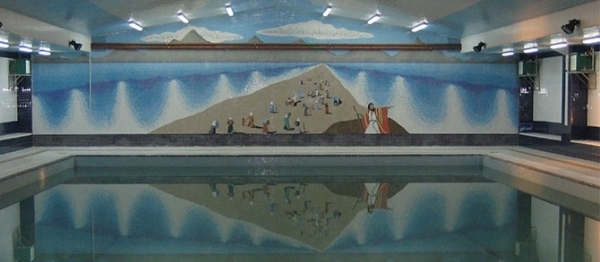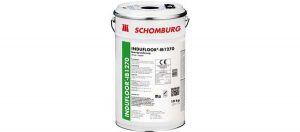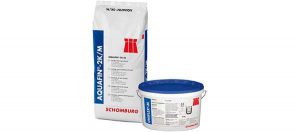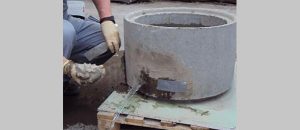UNIFIX® Art.-No. 2 05408
Tile Adhesive
Properties:
• Tested to DIN EN 12004, C1T
• For interior and exterior use
• Polymer modified
• Powder component of UNIFIX-2K and UNIFIX-2K/6
• Good slip resistance
Areas of application:
UNIFIX is used as a thin bed adhesive for the installation of vitrified and earthenware tiles, clinker, mosaic and natural stone materials with high water absorption, which are not sensitive to discolouration or translucent. UNIFIX is suitable for an assured installation to all substrates in accordance with DIN 18157, part 1 e.g. concrete, aerated concrete, render, plaster, cement-based and calcium sulphate based screeds / heated screeds, masonry work, plasterboard etc. It is also suitable as an adhesive for lightweight construction boards e.g. those made with extruded polystyrene and for the installation of tiles onto mineral-based and dispersion-based SCHOMBURG bonded waterproof membranes in wet duty class A0 in accordance with the ZDB data sheet
“bonded waterproof membranes”.
Technical Data:
Basis: cement / sand (polymer modified)
Colour: cement grey
Bulk density: 1.3 – ۱.۴ kg/dm3
Application /substrate temp: +5° C to +25° C
Pot life *): approx. 2 hrs
Open time *): approx. 10-15 mins
Grout after *): approx. 24 hrs
Foot traffic after *): approx. 24 hrs
Full service conditions *): after approx. 28 days
Cleaning: immediately after use with water
Testing: DIN EN 12004 MPA NRW test certificate 220002614-03
Consumption: approx. 2.5 kg/m² with a 6 mm notched trowel approx. 3.3 kg/m² with an 8 mm notched trowel approx. 4.1 kg/m² with a 10 mm notched trowel
Packaging: 25 kg bag
Storage: 12 months when stored dry in the original unopened packaging. Use opened packaging promptly.
* Values relate to +20° C and 65% relative humidity. Higher temperatures shorten, lower temperatures lengthen the given timings
Substrate preparation:
The substrate must be dry, load-bearing, adequately flat, free from penetrating cracks and free from separating substances such as oil, paint, laitance and loose areas. It must have a largely closed surface texture with a surface condition and strength commensurate with its type. When installing tiles, the substrate, its preparation and workmanship must conform to DIN 18157, part 1. Prime porous substrates with ASO-Unigrund. Calcium
sulphate screeds must be abraded, vacuumed and as with all calcium sulphate based substrates, primed with ASO-Unigrund-K, diluted 1:3 with water. Heated screeds must be commissioned to recognised technical regulations prior to the installation of floor finishes. The readiness of the substrate to receive surface finishes is to be determined by moisture measurements with a carbide hygrometer (CM device).
The CM moisture content may not exceed:
• CT ≤ ۲.۰% for screeds on insulation or separating layers, in interior areas
• CA without underfloor heating ≤ ۰.۵%
• CA with underfloor heating ≤ ۰.۳%
The CM measurement is to be carried out in accordance with the FBH-AD work instruction taken from the technical information “coordination of cut-out points
with heated screeds”.
Product preparation:
Mix UNIFIX with clean water in a clean mixing bucket until homogenous.
Mixing ratio:
6.75 – 8.25 litres water : 25.0 kg UNIFIX Allow to stand for a short while, then stir once again. Only prepare as much adhesive as can be used
within the pot life. Spread the mixed adhesive over the substrate surface and comb through with a suitable notched trowel dependent on the tile format and fix within the open time.
Advice:
• When installing tiles in more demanding conditions externally (balconies and terraces), use the highly elastic bonded waterproofing system AQUAFIN-2K/M and UNIFIX-2K.
• When fixing natural and synthetic stone, take the specific properties of the product (tendency to discolour, risk of curling) and the manufacturer’s installation recommendations into consideration. We recommend that a trial area is fixed.
• To avoid curling effects through water absorption, we recommend that when fixing agglomerate/synthetic stone ASODUR-EK98 is used.
• Thoroughly prime calcium sulphate based substrates with ASO-Unigrund-GE or ASO-Unigrund-K (mix ratio 1:3 with water). To avoid the formation of ettringite, UNIFIX-AEK is especially suited for installing tiles to calcium sulphate based substrates up to a residual moisture of 1.0% when heated and 1.5% when unheated (carbide hygrometer measurements).
• Adhesive, which has started to stiffen, should not be re-lifed through the addition of water or fresh mortar as there is a risk of inadequate strength development.
• Direct contact between cement-based adhesives and magnesite screeds leads to the destruction of the magnesite screed through chemical reaction. Prevent
moisture ingress from the rear using suitable means. Mechanically abrade the magnesite substrate and prime with the epoxy resin ASODUR-V360W mixed with max. 5% water as necessary (approx. 250 g/m²). After waiting from between 12 and 24 hours, apply a second coat of ASODUR-V360W (approx. 300 – ۳۵۰ g/m²). Blind the second coat, whilst still wet, with 0.5 – ۱.۰ mm quartz sand. Wait for a further 12 – ۱۶ hours then continue with the installation.
• In continuously wet areas (swimming pools, water features etc.), system thin-bed adhesives UNIFIX-2K, UNIFIX-2K/6 should be used with the butteringfloating technique over the SCHOMBURG waterproof membrane, appropriate for the conditions.
• UNIFIX is a hydraulically hardening mortar and should be protected from water and frost penetration until completely hardened, which may take a few days in unfavourable weather conditions.
• Protect areas not being treated from the effects of UNIFIX.
• Observe the relevant current regulations. E.g.
DIN 18157, DIN 18202
DIN 18352, EN 13813
DIN 18560, DIN 1055
The BEB information sheets, distributed by the Bundesverband Estrich und Belag e.V. The technical information “coordination of cut out
points in heated floor constructions”. The ZDB information sheets, distributed by the professional association of the German tile industry:
[*1] “Bonded waterproof membranes”
[*۲] “Tiling to calcium sulphate screeds”
[*۳] “Movement joints in wall and floor tile finishes”
[*۵] “Ceramic tiles, natural stone and cement-bound composite slabs on cement-based floor constructions with insulation”
[*۶] “Ceramic tiles, natural stone and cement-bound composite slabs on heated cement-based floor constructions”
[*۷] “Finishes in exterior areas”
[*۸] “Finishes on poured asphalt”
[*۹] “Tolerances in level”
[*۱۰] “Tolerances”
[*۱۱] “Cleaning, protecting, maintenance”
[*۱۲] “Swimming pool construction”
Please observe a current valid EU Health &
Safety Data Sheet.
GISCODE: ZP1




